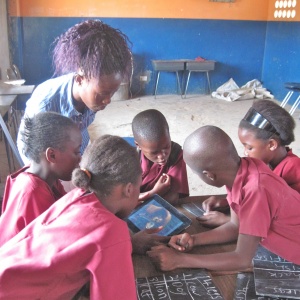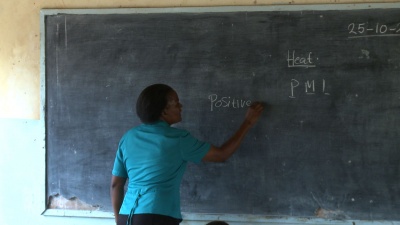OER4Schools/activities/Positives, Minuses, Interesting (PMI): Difference between revisions
JanetBlair (talk | contribs) (changed title (but didn't do a redirect)) |
JanetBlair (talk | contribs) m (finished with this for now, may add steps/hints later) |
||
| Line 3: | Line 3: | ||
The PMI activity is a useful starter activity when introducing students to enquiry-based learning (EBL). EBL encourages students to take the initiative to pose questions and explore their curiosity about the world around them, through a process of enquiry. Being able to consider alternative scenarios is a useful higher order thinking skill for learning by enquiry and the PMI activity encourages this way of thinking. It also gives students permission to think 'outside the box' in their responses. | The PMI activity is a useful starter activity when introducing students to enquiry-based learning (EBL). EBL encourages students to take the initiative to pose questions and explore their curiosity about the world around them, through a process of enquiry. Being able to consider alternative scenarios is a useful higher order thinking skill for learning by enquiry and the PMI activity encourages this way of thinking. It also gives students permission to think 'outside the box' in their responses. | ||
[[image: Martha 1.jpg|400px]] | [[image: Martha 1.jpg|400px]] | ||
A PMI activity involves considering the positive, negative and interesting points related to a specific scenario. It was originally developed by Edward de Bono, father of the “thinking skills” movement. It encourages learners to look at both sides of a situation and also to be creative when considering the interesting possibilities. There are no correct or incorrect answers so students should feel able to offer their ideas freely. | A PMI activity involves considering the positive, negative and interesting points related to a specific scenario. It was originally developed by Edward de Bono, father of the “thinking skills” movement. It encourages learners to look at both sides of a situation and also to be creative when considering the interesting possibilities. There are no correct or incorrect answers so students should feel able to offer their ideas freely. | ||
| Line 17: | Line 19: | ||
* P (positives): the plant could move to where there is more light or water | * P (positives): the plant could move to where there is more light or water | ||
* M (minusses): the plant would waste energy by moving | * M (minusses): the plant would waste energy by moving | ||
* I (interesting): we have to be sensitive and aware of plants walking on the roads and in our houses - there is a huge potential for creativity here as students explore the outrageous possibility of having plants walking around and the consequences that may bring | * I (interesting): we have to be sensitive and aware of plants walking on the roads and in our houses - there is a huge potential for creativity here as students explore the outrageous possibility of having plants walking around and the consequences that this may bring | ||
For further examples, navigate to: | For further examples, navigate to: | ||
http://www.azteachscience.co.uk/resources/continuing-professional-development/bright-ideas-in-primary-science.aspx | http://www.azteachscience.co.uk/resources/continuing-professional-development/bright-ideas-in-primary-science.aspx | ||
Latest revision as of 11:55, 23 July 2013
| Resource details | |
| Title | Positives, Minuses, Interesting (PMI) |
| Topic | |
| Teaching approach | |
| Learning Objectives | |
| Format / structure | |
| Subject | |
| Age of students / grade | |
| Table of contents | |
| Additional Resources/material needed | |
| Useful information | |
| Related ORBIT Wiki Resources | |
| Other (e.g. time frame) | |
| Files and resources to view and download | |
| Acknowledgement | This resource is part of the OER4Schools programme. |
| License | |
The PMI activity is a useful starter activity when introducing students to enquiry-based learning (EBL). EBL encourages students to take the initiative to pose questions and explore their curiosity about the world around them, through a process of enquiry. Being able to consider alternative scenarios is a useful higher order thinking skill for learning by enquiry and the PMI activity encourages this way of thinking. It also gives students permission to think 'outside the box' in their responses.
A PMI activity involves considering the positive, negative and interesting points related to a specific scenario. It was originally developed by Edward de Bono, father of the “thinking skills” movement. It encourages learners to look at both sides of a situation and also to be creative when considering the interesting possibilities. There are no correct or incorrect answers so students should feel able to offer their ideas freely.
Consider the following imaginary scenario: Plants can now walk in our world!
(It is important to realise that plants do not need to move because they make their own food by photosynthesis – animals have to move in order to forage for food.)
What would be some positives, minuses or interesting points you can think of, if this scenario was actually true?
Possible responses:
- P (positives): the plant could move to where there is more light or water
- M (minusses): the plant would waste energy by moving
- I (interesting): we have to be sensitive and aware of plants walking on the roads and in our houses - there is a huge potential for creativity here as students explore the outrageous possibility of having plants walking around and the consequences that this may bring
For further examples, navigate to: http://www.azteachscience.co.uk/resources/continuing-professional-development/bright-ideas-in-primary-science.aspx


